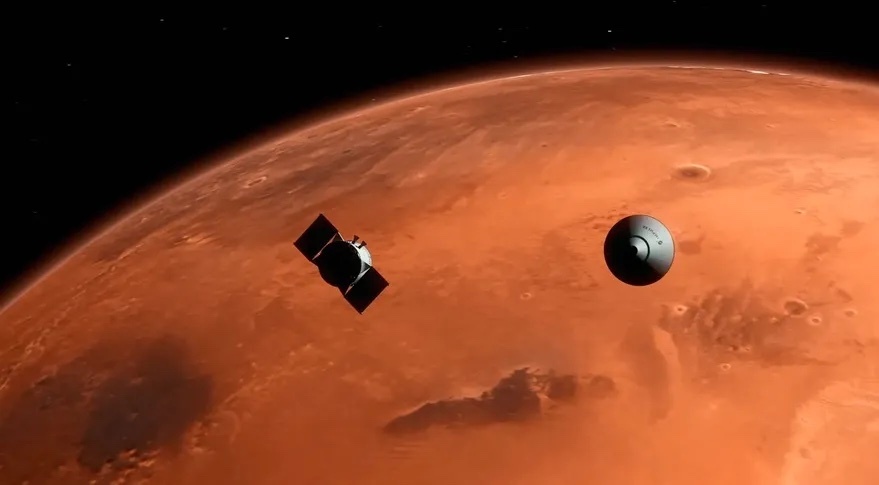26.05.2023

An illustration of a Mars lander, within its entry capsule, separating from its cruise stage upon arrival at Mars. Impulse Space would build the lander and Relativity Space would launch it. Credit: Impulse Space
WASHINGTON — Two companies are preparing for a 2026 launch of what they believe will be the first commercial robotic Mars lander mission, the start of what the companies plan to be a regular series of such missions.
Impulse Space and Relativity Space announced last July plans for the lander mission, with Impulse leading development of the lander itself and Relativity providing the launch on its Terran R rocket in development. At the time they were proposing to launch the mission in the next window for Mars missions in late 2024.
However, in a presentation at the recent Humans to Mars Summit, executives with the two companies said the mission is now scheduled for launch in 2026. They did not disclose the reason for the delay, but Relativity Space announced in April that a redesigned version of the Terran R rocket will make its debut in 2026, two years later than previously planned.
While the launch of the first Mars mission may have slipped, the companies said at the conference that they are committed to flying a series of such commercial lander missions, creating what Josh Brost, senior vice president of revenue operations at Relativity, called a “constant supply chain to Mars.”
That means flying missions at every launch opportunity, roughly two years apart. “We will take advantage of the window every 2.2 years and take at least one mission up,” said Barry Matsumori, chief operating officer of Impulse Space. He said the companies would offer a catalog of different payload options, “and that catalog will drive the missions we actually do.”
They argued that having a frequent series of missions will enable new and lower cost science, including the ability to refly payloads. “By making transport to Mars more affordable, you open up that iteration loop that can lead to advancements that just could not have been envisioned previously,” said Brost.
Matsumori added they have also seen interest from commercial customers, such as those flying payloads for marketing purposes. The companies have not disclosed any customers yet or the pricing for payloads on the lander.
The companies have also shared few technical details about the lander, but noted they plan to leverage designs and technologies developed for NASA’s InSight Mars lander, such as its heat shield. “We’re not trying to reinvent the wheel,” Brost said. “Doing a clean-sheet design of a lander is an insane, monumental engineering feat.”
Impulse is making progress on the propulsion needed for the lander. The company announced May 10 it completed qualification testing of Saiph, a five-pounds-force thruster, for use on its first mission to low Earth orbit slated to launch in October. That thruster will also handle maneuvers of the Mars lander during its cruise to the planet, Matsumori said.
Impulse is also working on Rigel, which will produce 180 pounds-force of thrust, that will be used for landing on Mars. “The number one thing that all space vehicles start with is propulsion systems, and that is a challenge that we feel pretty comfortable with,” he said.
The companies see NASA as one potential customer of those landers. “We hope that our own government, NASA, can take advantage of what we’re doing,” Matsumori said, “so that they don’t worry about the transport, but about the science itself.”
NASA has expressed an interest in eventually buying commercial services for Mars science missions. A draft robotic Mars exploration strategy released by NASA in Marchopened the door to acquire services for Mars science missions in a manner analogous to the Commercial Lunar Payload Services program of robotic lunar lander missions.
“There is no shortage of companies that have interest,” Eric Ianson, director of NASA’s Mars Exploration Program, said during a March 30 presentation about the strategy. “The real question is, do they have the capability to be able to do that job?”
The companies said they want to demonstrate with their lander mission that there are companies both interested in and able to take on Mars missions. “Our long-term vision has been to be one of the companies that makes a permanent presence on Mars possible,” Brost said.
That’s been a goal long associated with SpaceX and its founder, Elon Musk, who frequently talks about making humanity multiplanetary. “In the last several years, there’s really been one loud commercial voice talking about Mars,” Brost said, alluding to SpaceX. “But for Mars to really happen and be affordable and sustainable and all of those things, it doesn’t take one company. It takes dozens or hundreds. You need lots of different people working on different parts of the problem set.”
Quelle: SN
